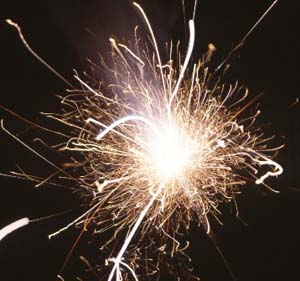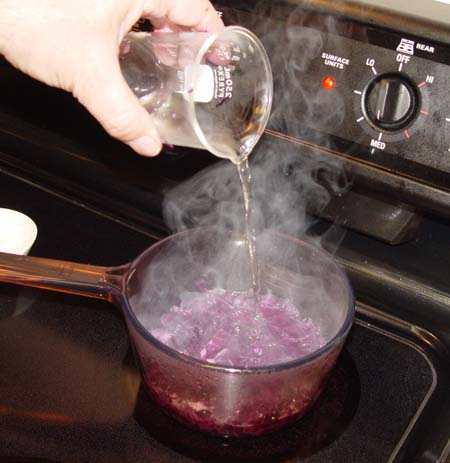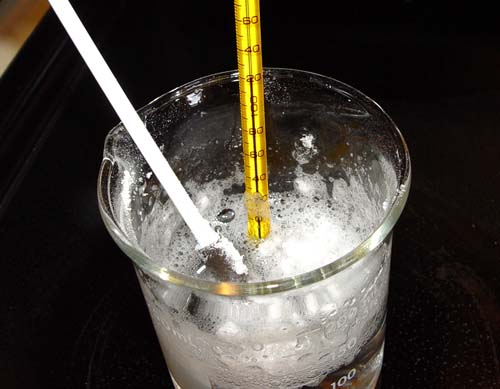


Last updated August 22, 2011
|
Safety Tutorial for CHM-107 Lab
|
|
OSHA (Occupational Safety & Health
Administration) says that you have the legal right to know what chemicals
you might be exposed to and what their dangers are. This is true of employees,
customers, and students. For example, if you worked at a restaurant, your
employer is suppose to have available to you the list of chemicals (not
food) that you might come in contact with on the job and a description
of their dangers. These are usually presented in material safety data
sheets (MSDS for short).
|
| Often in material safety data sheets you will find the rating given by the National Fire Protection Association. This rating was designed to be placed on diamond-shaped signs so that fire fighters would know what hazards were present when fighting a chemical fire. These signs are placed on transport vehicles, on buildings containing chemicals, and on containers of chemicals. The numbers range from 0 to 4, with 4 meaning the most hazardous. At a glance, a person can tell what the dangers are. For example, the diamond with 4,4,4 would tell you this is something extremely toxic, extremely flammable, and could explode. Fire fighters would keep their distance. |
 |
  |
| Health: 4-Deadly 3-Extreme Danger 2-Hazardous 1-Slightly Hazardous 0-Normal materials |
Fire
Hazard: 4-Very Flammable 3-Readily Ignitable 2-Ignited with heat 1-Combustible 0-Will not burn |
Reactivity Hazard: 4-May Detonate 3-Shock & Heat may detonate 2-Violent chemical change 1-Unstable if heated 0-Stable |
Specific Hazard: OXY = Oxidizer (concentrated source of oxygen or something that behaves like oxygen) ACID- acid ALK – Alkali (corrosive to skin, reacts violently with acidic material) COR- Corrosive |
| The health and fire hazard warnings are self-explanatory. The Reactivity Hazard is mostly looking at high speed reactions which can make it explode. Other types of reactivity may be indicated in the Specific Hazard diamond. |  |
| OXY means that it can be a source of oxygen or have elements that will behave like oxygen. The chemicals don't burn themselves but speed up the burning of other chemicals. For example, potassium chlorate when heated releases oxygen atoms. When this happens, simple things like paper, plastic, wood, sugar, coins, and oil will burn white hot like a flare and could explode. |  |
| ACID means that the chemical is an acid. Strong acids can dissolve metals and release explosive hydrogen gas. It can react with other chemicals to produce a lot of heat that can start a fire. It can react with chemicals that release toxic and non-toxic gases. However, any release of gases can build up pressure and explode. Common strong acids are sulfuric acid (battery acid), hydrochloric acid (pool acid), and nitric acid. |  |
|
ALK means that the chemical is alkaline which means the opposite of acid but just as dangerous. The word "alkaline" comes from a plant that grows next to salty lakes or oceans. In Arabic, it's called "Al Kali" or the saltwort plant. The ashes of this plant neutralizes acids. That is why chemicals that neutralize acids are called alkaline. Strong alkaline chemicals are especially corrosive to skin (it turns skin into soap). Alkaline chemicals neutralize acids but in the process can put out tremendous amounts of heat that can start fires and generate gases that can build up explosive pressures. Common alkaline chemicals are ammonia (a gas used in agriculture), cleaning ammonia (ammonium hydroxide), sodium hydroxide (Drano drain opener, Easy Off oven cleaner & Red Devil soap making Lye). These chemicals can be dangerous by themselves but are more dangerous mixed with acids. |
 |
|
COR means that the chemical is corrosive but not because of acid or alkaline properties. It might be corrosive because of it reacts violently with water and if exposed to the moisture in skin, damages skin. Chemicals used in the computer chip industry like phosphorus trichloride, boron trichloride, aluminum trichloride, and silicon tetrachloride are in this category. Picture is a leak from a truck carrying 12 tons of phosphorous trichloride, which has the NFPA warning of Health=4 (deadly), flammability=0 (non-flammable), reactivity=2 (violent chemical change). The Specific Hazard is listed a Water Reactive. Corrosive and irritating to living tissue. Toxic level exposure to skin causes acid-like burns. In contact with water (in tissue or with liquid water) it creates hydrochloric acid and phosphoric acid. |
 |
| Some chemicals are corrosive because they react (combine) with other materials aggressively. For example, gases of the elements chlorine, fluorine, and iodine react detrimentally with human tissue and other materials. Chlorine gas is often used in public swimming pools to disinfect the water. Several emergenices have been caused by leaks of chlorine gas. |  |
|
You should feel at ease because in your chemistry kit, there are no chemicals that would warrant any of these warnings. |
|
MATERIAL SAFETY DATA SHEETS
|
|
| Material Safety Data Sheet documents can be found on the Web. The MSDS sheets have a lot more information about the chemical as well. For example, the NFPA rating of 2 for health means it is hazardous, but the MSDS gives more specifics on what health hazards is involved. |
 |
| Let's look at some examples of MSDS information: | |
| CHALK: This is in your kit and you are all familiar with the chalk at the blackboards that gets all over the room. The material safety data sheet gives rating for the NFPA diamond, which indicates that health has a rating of one, which means that it is slightly dangerous. The zero in the red means it does not burn, and the zero in the yellow means it is not reactive and is stable. One MSDS states chalk is "Irritating to the skin and eyes on contact. Inhalation will cause irritation to the lungs and mucus membrane. Irritation to the eyes will cause watering and redness. Reddening, scaling, and itching are characteristics of skin inflammation. Follow safe industrial hygiene practices and always wear protective equipment when handling this compound." |
 |
|
EASY OFF OVEN CLEANER: This is not in the kit but may be in your kitchen. One MSDS gives the rating of 3 for health, which is extreme danger (see diamond). It also states, "Inhalation: Not toxic by inhalation. Eye Contact: Corrosive to eyes. Skin Contact: Corrosive to skin. Signs and symptoms of overexposure include reddening of skin, tissue destruction, delayed pain. Ingestion: Not orally toxic; however, product is corrosive to mucosal membranes." In this case, the MSDS is not exaggerating. One ingredient at 5% concentration is sodium hydroxide, which is quite corrosive, especially to the skin and eyes. The warning on the label on the can says to wear gloves, but it would also be a good idea to wear goggles as well. A web site that has the MSDS for many household products
is
|
 |
|
The chemical used as a soil substitute is called sodium
polyacrylate: As you can see from the NFPA sign the chemical is safe in all three areas: Health, flammability, and reactivity (explosiveness). One MSDS publisher does say it can be irritating to skin or eyes. (but that's about true of about any powder). This is a chemical in your kit.
|
 |
| The table below lists the chemicals in the chemistry kit and the key information from their MSDS (Material Safety Data Sheets). Become familiar with the hazards. | |
|
Table of safety data for Chemicals
in Chemistry Kit
built from online Material Safety Data Sheets (MSDS) |
| Chemical Name |
Health
|
Flammability
|
Reactivity
|
Skin contact
|
Eyes
|
Ingestion
|
Inhalation
|
Protection |
| Borax, 7 grams |
0=none
|
0=none
|
0=none
|
safe
|
safe
|
OK if less than teaspoon
|
mild irritant | |
| Sodium polyacrylate |
0=none
|
0=none
|
0=none
|
may irritate
|
may irritate
|
Not toxic but may expand in stomach
|
No hazard expected | |
| Polyvinyl alcohol |
0=none
|
2=moderate
|
0=none
|
safe
|
may irritate
|
Safe, no hazard expected | Not expected | |
| Activated charcoal, 3.5 grams |
1=slight
|
1=slight
|
1=slight
|
may irritate
|
may irritate
|
OK unless large quantities
|
mild irritant | Goggles |
| Potassium iodide, 2.5 grams |
1=slight
|
0=none
|
1=slight
|
may irritate
|
may irritate
|
Large doses may irritate GI tract. Induce vomiting
|
Irritation: coughing, shortness of breath | Goggles |
| Cornstarch |
0=none
|
1=slight
|
0=none
|
safe
|
may irritate
|
OK unless large quantities
|
irritation | |
| Sodium bicarbonate (baking soda) |
0=none
|
0=none
|
1=slight
|
may irritate
|
may irritate
|
OK unless large quantities
|
irritation | |
| Sodium carbonate (washing soda) |
1=slight
|
0=none
|
1=slight
|
causes irritation
|
causes irritation
|
Slightly toxic. Give 1-2 glasses of water, call physician
|
irritation | Goggles |
| Ion exchange resin-sodium |
0=none
|
1=slight
|
0=none
|
safe
|
may irritate
|
OK unless large quantities
|
OK unless large amount | |
| Ion exchange resin-Deionizing |
0=none
|
1=slight
|
0=none
|
may irritate mildly, redness
|
may irritate
|
OK unless very large quantities
|
Not expected to be health hazard | |
| Soil test Floc-Ex tablets |
1=slight
|
0=none
|
0=none
|
may irritate
|
may irritate
|
Harmful if swallowed, drink plenty of water, call physician
|
Not expected but irritant | Goggles |
| Soil test Phosphorous tablets |
1=slight
|
0=none
|
0=none
|
may irritate
|
may irritate
|
Do not induce vomiting, drink plenty of water, call physician
|
No hazard expected | Goggles |
| Soil test Potassium tablets Sodium Tetraphenylboron <10% |
1=slight
|
0=none
|
0=none
|
may irritate
|
may irritate
|
Harmful if swallowed, drink plenty of water, call physician
|
Not expected | Goggles |
| Soil test Nitrate CTA tablets (zinc dust 1%) |
1=slight
|
0=none
|
0=none
|
may irritate
|
may irritate
|
Harmful, induce vomitting, drink plenty of water, call
physician
|
Not expected | Goggles |
| Sulfur, 50 milligrams= 0.05 grams |
1=slight
|
3=severe
|
0=none
|
may irritate
|
irritant, redness, pain
|
Considered nontoxic except in large doses
|
May cause coughing if large amounts | Goggles |
| Phenolphthalein, <50 milligrams |
1=slight
|
1=slight
|
0=none
|
my irritate | irritant | Once used as laxative but halted because suspected cancer hazard | Not expected | |
| Chalk (calcium carbonate) |
1=slight
|
0=none
|
0=none
|
may irritate
|
redness, itching
|
If large amounts swallowed, give water, get medical advice
|
Irritation to lungs and mucous membranes | |
| Biodiesel |
0=none
|
1=slight
|
0=none
|
may irritate
|
may irritate
|
may cause gastro-intestinal irritation | Not expected | |
| Glycerin |
1=slight
|
1=slight
|
1=slight
|
may irritate
|
may irritate
|
irritation in large amounts | Not expected | |
| Test strips |
No MSDS given for these probably
because of such small quantities and the chemicals are glued to the strips.
|
|||||||
| pH test papers |
No MSDS given for these probably
because of such small quantities and the chemicals are embedded in the
paper
|
|||||||
| Skin Irritation |
Skin irritation of these chemicals is handled by washing
with soap and water. If irritation persists, seek medical advice.
|
|||||||
| Eye Irritation | Eye irritation of these chemicals is handled by flushing with water for 15 minutes. If irritation persists, seek medical advice. | |||||||
Other Lab Safety Practices |
|
FIRE SAFETY: Getting burned or setting something on fire is a major concern. There are two labs that will need the use of a heat source. You will use the stove or a microwave oven. Whenever something gets heated, there is a danger of getting burned or starting a fire. Also, glass sometimes breaks when heated. So be extra careful on those two labs just like being careful when cooking. |
 |
GLASSWARE SAFETY: Glass is resistant to chemicals and heat, so it's a common item in labs. But as you know, when glass breaks, it can cut you. Your kit has several items that are made of glass including a glass thermometer, which is probably the easiest item to break. So be extra careful with the thermometer. Graduated cylinders are usually made of glass, but we choose plastic ones for the kit just for extra safety. |
 |
CHEMICAL SAFETY: Most chemicals in your kit are fairly safe to be around but that doesn't mean they are necessarily safe to touch, taste, or even smell. For example, you have worked with gasoline, which is considered quite dangerous, but if you don't expose the gas to a flame, taste it, or inhale it, then you can handle it safely. So working with chemicals in your kit is like that. They are fine if you avoid contact with them. Gloves are included in the kit for the times your will be working with chemicals that are not good to contact. |
 |
EYE SAFETY: Your eyes are the most vulnerable part of your body and the most important. Your kit has goggles for eye protection. The lab instructions will remind you when goggles are needed. The goggles in your kit are made to resist liquid splashes to the eyes. Normal glasses or other kinds of safety glasses are not good at stopping liquid from getting in the eyes. |
 |
Hits from different computers since Aug,
2007